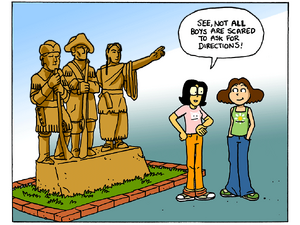| Lewis and Clark | |||
|---|---|---|---|
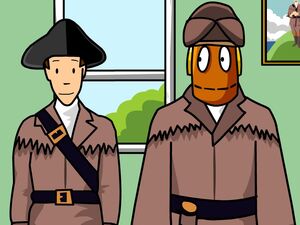 | |||
| Airdate | June 22, 2005 Remake: September 30, 2020 | ||
| Curriculum | Social Studies | ||
Lewis and Clark is a BrainPOP Social Studies video which launched on June 22, 2005. Over 15 years, a remake launched.
Summary[]
Update[]
Tim answers a letter about Lewis and Clark. Tim and Moby are talking about Lewis and Clark.
Old[]
Tim answers a letter about Lewis and Clark. Tim and Moby are talking about Lewis and Clark.
Appearances[]
Transcript[]
Trivia[]
- The music that plays during the video is Ashokan Farewell, a violin melody written by Jay Unger.
- The opening credits read:
- Starring Moby Calrissian
- Produced by Moby Calrissian
- Directed by Moby Calrissian
- Moby is Awesome!
- The end credits read (in alphabetical order):
- Starring Moby Calrissian
- Produced by Moby Calrissian
- Directed by Moby Calrissian
- Thank you to:
- Amber Alvarez
- Amber Jolliffe
- Amit Gilon
- Anat Shayovits
- Ani Mator
- Annie Choi
- Assaf Mizrahi
- Assaf Sade
- Aviad Segal
- Avraham Kadar
- Becca Hunt
- Ben Courtney
- Benjamin Issembert
- Brian Levinson
- Carol Kim
- Channy Kempner
- Charlie Slevin
- Dana Prop
- Daniel Rowe
- Daphna Oren-Magidor
- Del Almeida
- Demian Johnson
- Einat Kadar
- Elisya Shahaf
- Ericka Goodman
- Erin Skrypek
- Etty Kochavi
- Eva Bakova
- Eva Yaffe
- Gabriel Kahan
- Godfrey Deeny
- Grant Lamos
- Grant Lamos IV
- Gregor Milne
- Hadas Nilchum
- Helen Chang
- Hernan Arber
- Jeanette Montalvo
- In the updated version of this movie, it no longer shows Tim and Moby dressing up as Lewis and Clark.
- In addition, the end credits no longer appear at the end of the movie.
Quiz[]
FYI[]
Dollars & Cents[]
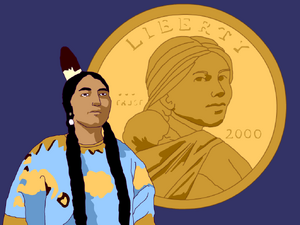
We’re used to seeing Presidents on American coins. So when Sacagawea was chosen in 1998 to appear on a new $1 coin, it said a lot about her status as one of the most important women in U.S. history.
Known as the Sacagawea Dollar or the Golden Dollar, the U.S. Mint issued the coin in 2000 as a replacement for the Susan B. Anthony Dollar, first released in 1979. The public often complained that the Susan B. Anthony Dollar was too similar to a quarter, leading to costly mix-ups! So the Sacagawea Dollar was given a smooth outside edge and an eye-catching gold color (even though it’s mostly made of copper) to set it apart.
The United States $1 Coin Act of 1997 passed by Congress required the new coin to feature an important woman whose legend had stood the test of time — and Sacagawea fit the bill perfectly! Since no images of the actual Sacagawea exist, a 22-year-old Shoshone woman named Randy’L He-dow Teton (pictured) was used as the model for the image on the coin, which also includes Sacagawea’s young son Jean Baptiste.
But just like the Susan B. Anthony Dollar, the Sacagawea Dollar never really caught on, and production stopped in 2002 due to low demand. Still, you can find them in banks and as change in automated vending machines. And in 2009, a new version of the Sacagawea Dollar was released as part of a bigger campaign to honor American Indians and their contributions to U.S. history!
Flora And Fauna[]
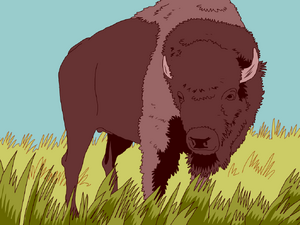
They may have been trained as soldiers, but Meriwether Lewis and William Clark played the roles of scientists, too. Here’s a brief rundown of some of the exotic life forms they encountered on their journey through the West.
Mammals: The plains and forests of the west were teeming with huge herds of large mammals like bison (pictured), elk, and deer, which provided the main supply of meat for the explorers. They also hunted bears, beavers, and black-tailed prairie dogs.
Plants: Before the expedition began, Lewis took a crash course in botany. That’s why he was able to identify and collect so many trees, shrubs, and wildflowers, including 94 plant species that had never been studied before!
Birds: The information that the team gathered about birds was less accurate than its notes on plants and animals. Some bird descriptions were so bad that we’re still not sure what species the explorers were describing! But they got some species right — about 50 in all, including the passenger pigeon, the California condor, and the black-billed magpie.
Fish: According to the explorer’s journals, rivers like the Columbia were teeming with fish like salmon and trout, a major food source for American Indians. Today, these populations have nearly disappeared, thanks to pollution and other human influences.
Reptiles: The explorers described fewer than a dozen reptiles, possibly because there were so many mammals, birds, and plants to study. One exception was the rattlesnake, which they found throughout the plains and the Rocky Mountains. These snakes were too abundant — and too dangerous — to ignore.
Trivia[]
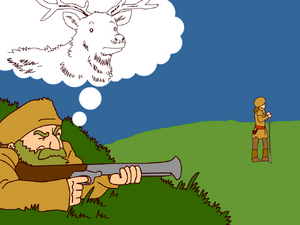
- Lewis and Clark were not the first explorers to reach the Pacific Ocean by land. In 1793, Scottish explorer Sir Alexander Mackenzie led a Canadian expedition to the West Coast. Before that, Spanish explorer Cabeza de Vaca and four other men reached the Pacific in 1536.
- One goal of the Lewis and Clark expedition was to locate a central waterway that could be used as a trade route to bridge the continent. As the explorers soon discovered, this waterway didn’t exist!
- Lewis and Clark didn’t bring any pack animals when they started out on their journey. But once they saw the Rocky Mountains, they knew they would need horses to cross them. In August of 1805, the expedition encountered a group of Shoshone Indians, led by Chief Cameahwait. Hoping to trade for horses, Lewis and Clark asked Sacagawea to translate. When she saw the Shoshone chief, she couldn’t believe her eyes — it was her long-lost brother! After a joyful reunion, the Shoshones traded horses and supplies with Lewis and Clark.
- The only death suffered by the expedition was Sergeant Charles Floyd, who died on August 20, 1804, from what was probably a burst appendix.
- During the journey, the expedition sent many specimens of plants and animals back to President Jefferson — including a live black-tailed prairie dog!
- Near the end of the journey home, Lewis was accidentally shot by one of his own men. On August 11, 1806, a hunter who was blind in one eye and nearsighted in the other mistook Lewis for an elk (pictured) and shot him in the thigh!
Did You Know[]
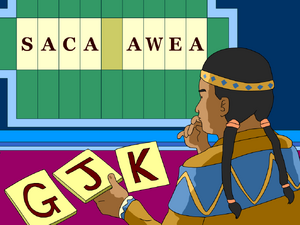
Sacagawea. Sacajawea. Sakakawea. So which one is the correct spelling? Depending on who you ask, all of them! In Meriwether Lewis and William Clark’s original journals of their famous expedition, they wrote the name of the Shoshone Indian woman 17 times — and spelled it eight different ways! But one thing all the spellings had in common was the letter “g.”
According to the journals, the name actually means “bird woman” in the Hidatsa langauge. Based on this, most historians and government organizations like the U.S. Bureau of American Ethnology adopted “Sacagawea” as the official correct spelling, pronounced with a hard “g” sound.
This also explains the next most widely-accepted spelling, “Sakakawea.” Some linguistics experts say it’s a more accurate English version of the original Hidatsa terms for “bird” (“sakaka”) and “woman” (“wea”). This is the official spelling used by the modern-day Hidatsa Indians and throughout North Dakota, where she’s a local hero!
And then there’s “Sacajawea,” the spelling that’s probably the most popular — and also the least accurate! For some reason, a “j” was used instead of a “g” by Nicholas Biddle, the banker who edited Lewis and Clark’s journals for publication in 1814.
The Shoshone Indians claim this spelling is closer to her original Shoshoni name, which means “boat launcher,” not “bird woman.” They believe the Hidatsa version simply came from her kidnappers mispronouncing her Shoshoni name.
In Depth[]
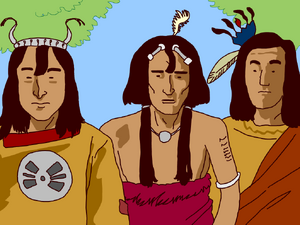
One of the main goals of the Lewis and Clark Expedition was to make contact with American Indian tribes living in the Louisiana Purchase territory.
On May 25, 1804, the expedition passed the small village of La Charette, which was known as the last white settlement on the Missouri River. The explorers felt sure that a run-in with Indians was just around the bend. But as it turned out, they would travel more than 1,110 kilometers up the river before that first encounter!
At sunset on August 2, a group of Oto and Missouri Indians showed up at the expedition’s camp. During this friendly meeting, the explorers gave the Indians gifts, including American flags and several peace medals stamped with the image of President Thomas Jefferson. It was a great start, but Lewis and Clark knew that they were about to enter the territory of the powerful Sioux Indians, who might not be as welcoming as the Oto and Missouri.
On August 30, the expedition met up with a group of peaceful Yankton Sioux (pictured). As with the Oto and Missouri, the explorers exchanged gifts with them. While these Indians were clearly disappointed by the gifts, they were friendly — and they warned Lewis and Clark about the Teton Sioux, their more warlike neighbors up the river.
The explorers soon discovered that the warning was right! The Teton Sioux rejected their gifts and demanded a boat as the price of passage through their land. As the Indians became more aggressive, the explorers got ready to defend themselves: Clark drew his sword, and Lewis pointed the gun on the expedition’s keelboat toward the Indians. But both sides backed off at the last moment, and a fight was avoided.
Unsolved Mysteries[]
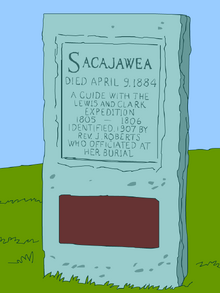
While most historians agree that Sacagawea died in 1812 as a young woman in her 20s, there’s a popular theory that says she actually survived until 1884, when she would have been almost 100 years old! It’s all based on the story of an elderly Shoshone woman who lived at the Wind River Indian Reservation in Wyoming until her death on April 9, 1884. According to official records and people who knew her, her name was Porivo, which means “chief woman” in the language of the Comanche Indians.
When she was alive, Porivo spoke about her experiences helping white men on a long journey, and she even had a silver Indian Peace Medal from the U.S. government — the exact kind carried by Lewis and Clark.
According to Porivo, she left her husband Toussaint Charbonneau several years after the Lewis and Clark expedition and set off across the Great Plains. She then married into a tribe of Comanche Indians and had many children.
After her husband’s death, Porivo claimed, she traveled to Wyoming, where she rejoined her original people, the Shoshone Indians. It was there that she died in 1884 — 72 years later than the widely accepted historical record!
Most historians don’t pay too much attention to this tale, but it still has its share of believers, thanks to several books published during the 20th century. There’s even a monument to “Sacajawea of the Shoshonis” on the Wind River reservation.
FYI Comic[]
